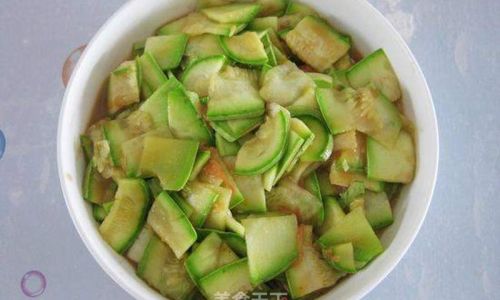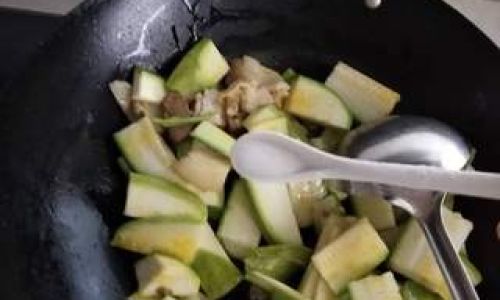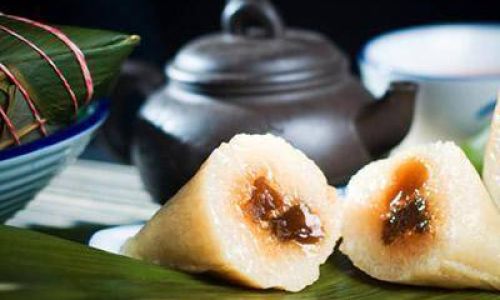Stir-frying, a cornerstone of Asian cuisine, transforms simple ingredients into culinary masterpieces with its emphasis on high heat, quick cooking, and bold flavors. Among the many vegetables that shine in this preparation method, zucchini—often referred to as “角瓜” (jiǎo guā) in Chinese—stands out for its mild sweetness, tender texture, and ability to absorb seasonings. This article delves into the intricacies of creating a restaurant-quality stir-fried zucchini dish at home, exploring ingredient selection, knife skills, heat management, and flavor pairing. Whether you’re a novice cook or a seasoned home chef, this guide will equip you with the knowledge to elevate this humble vegetable into a dish that tantalizes the palate and nourishes the body.
The Allure of Stir-Fried Zucchini
Zucchini, a member of the summer squash family, is celebrated for its delicate flavor and high water content. When stir-fried correctly, it retains a satisfying crunch while developing a caramelized exterior that adds depth to every bite. Unlike boiled or steamed zucchini, which can become mushy, stir-frying preserves the vegetable’s structural integrity, making it an ideal candidate for quick, vibrant meals. Additionally, zucchini is a nutritional powerhouse, rich in vitamins A and C, fiber, and antioxidants, making this dish both delicious and health-conscious.
Ingredients: Building Flavor from the Ground Up
The beauty of stir-fried zucchini lies in its simplicity. A handful of pantry staples can transform this vegetable into a dish that bursts with umami, spice, and freshness. Here’s a breakdown of the key components:
-
Zucchini Selection: Opt for firm, unblemished zucchinis with glossy skin. Smaller to medium-sized specimens (6–8 inches long) are ideal, as they tend to be sweeter and less watery than their larger counterparts. Avoid zucchinis with soft spots or a dull appearance, as these may indicate overripeness.

-
Aromatics: Garlic and ginger form the flavor backbone of this dish. Fresh garlic cloves, minced or sliced, add a pungent kick, while ginger imparts a warm, citrusy note. For a twist, try adding shallots or scallions for an extra layer of complexity.
-
Aromatic Oil: Use a neutral oil with a high smoke point, such as peanut, vegetable, or canola oil. These oils withstand high heat without burning, ensuring even cooking. For a nutty twist, sesame oil can be added at the end as a finishing touch.
-
Seasonings: A blend of soy sauce (or tamari for gluten-free diets), rice vinegar, and a pinch of sugar balances the dish’s flavors. For heat, incorporate chili flakes, fresh chili peppers, or a dash of Sriracha. Optional additions like oyster sauce or hoisin sauce can deepen the umami profile.
-
Texture Enhancers: Toasted sesame seeds, crushed peanuts, or a sprinkle of chili threads add visual appeal and crunch. For a creamy contrast, consider a dollop of silken tofu or a drizzle of tahini.
Preparation: The Foundation of Excellence
Stir-frying is a dance of precision and speed, making meticulous preparation essential. Follow these steps to ensure your ingredients are ready for the wok:
-
Washing and Drying: Rinse the zucchini under cool water to remove dirt. Pat dry thoroughly with a clean kitchen towel or paper towels. Excess moisture can cause the vegetable to steam rather than sear, resulting in a soggy texture.
-
Cutting Techniques:
- Julienne: Slice the zucchini into thin, matchstick-like strips. This shape maximizes surface area, promoting even cooking and caramelization.
- Half-Moons: Cut the zucchini diagonally into ¼-inch-thick ovals. This method offers a balance of texture and visual appeal.
- Wedges: For a heartier presentation, quarter the zucchini lengthwise and slice into 1-inch pieces.
Regardless of the cut, consistency is key. Uniform pieces ensure even cooking.
-
Mise en Place: Measure and prepare all ingredients before heating the wok. Stir-frying happens rapidly, leaving no time for chopping mid-cook.
The Stir-Frying Process: Mastering Heat and Motion
Stir-frying is as much about technique as it is about ingredients. Follow these steps to achieve wok hei—the coveted “breath of the wok” that imparts a smoky, charred flavor:
-
Heating the Wok: Place your wok or large skillet over high heat. Allow it to become scorching hot (a drop of water should evaporate instantly). Add a tablespoon of oil and swirl to coat the surface.

-
Searing the Aromatics: Toss in the garlic and ginger, stirring constantly for 10–15 seconds until fragrant. Avoid burning, which can impart bitterness.
-
Adding the Zucchini: Introduce the zucchini to the wok, spreading it in a single layer if possible. Let it cook undisturbed for 1–2 minutes to develop a golden sear. Stir vigorously with a spatula or wok ladle, ensuring all sides are exposed to heat.
-
Seasoning: Drizzle the soy sauce, rice vinegar, and sugar over the zucchini. Toss to coat evenly. The high heat will cause the liquid to reduce quickly, concentrating the flavors.
-
Finishing Touches: For added complexity, toss in chili flakes or a splash of sesame oil during the final 30 seconds of cooking. Remove from heat immediately to prevent overcooking.
Troubleshooting Common Pitfalls
Even seasoned cooks encounter hurdles. Here’s how to address common issues:
- Soggy Zucchini: Overcrowding the wok traps steam, leading to mushiness. Cook in batches if necessary.
- Uneven Cooking: Inconsistent cutting sizes result in uneven doneness. Use a sharp knife and take care during prep.
- Lack of Flavor: Under-seasoning is a common mistake. Taste and adjust seasonings before serving.
- Burnt Garlic: Add aromatics after the wok is hot, and stir constantly to prevent scorching.
Variations and Cultural Adaptations
Stir-fried zucchini is a canvas for creativity. Experiment with these regional and dietary adaptations:
- Sichuan-Style: Add doubanjiang (fermented chili bean paste) and Sichuan peppercorns for a麻辣 (má là) tingle.
- Korean Inspired: Incorporate gochujang (fermented chili paste) and a sprinkle of toasted sesame seeds.
- Mediterranean Twist: Swap soy sauce for lemon juice and toss in crumbled feta and chopped mint.
- Vegan/Gluten-Free: Use tamari instead of soy sauce and omit oyster sauce. Add nutritional yeast for a cheesy umami boost.
Serving Suggestions and Pairings
Stir-fried zucchini pairs beautifully with a variety of dishes:
- Rice Bowls: Serve over steamed jasmine rice with a fried egg on top.
- Noodle Stir-Fries: Toss with udon or soba noodles for a heartier meal.
- Appetizer Platter: Arrange on a platter with pickled vegetables and dumplings.
- Grain Bowls: Combine with quinoa, roasted chickpeas, and a tahini dressing.
Storage and Leftovers
Leftover stir-fried zucchini can be stored in an airtight container in the refrigerator for up to 3 days. Reheat gently in a skillet over medium heat to maintain texture. Avoid microwaving, as this can soften the zucchini further.
The Philosophy of Stir-Frying: Lessons Beyond the Kitchen
Stir-frying is more than a cooking method—it’s a metaphor for balance and harmony. The interplay of heat, timing, and ingredients mirrors life’s impermanence and the beauty of embracing simplicity. As you master this dish, consider the deeper lessons it offers: patience in preparation, mindfulness in execution, and humility in accepting that perfection lies in imperfection.
Conclusion: Elevating the Everyday
Stir-fried zucchini is a testament to the magic of minimalism. With just a handful of ingredients and a willingness to engage with the process, you can create a dish that delights the senses and nourishes the soul. Whether you’re cooking for one or a crowd, this recipe invites you to slow down, savor the moment, and rediscover the joy of wholesome, flavorful food. So grab your wok, sharpen your knife, and let the sizzle of the pan guide you toward culinary mastery.





0 comments